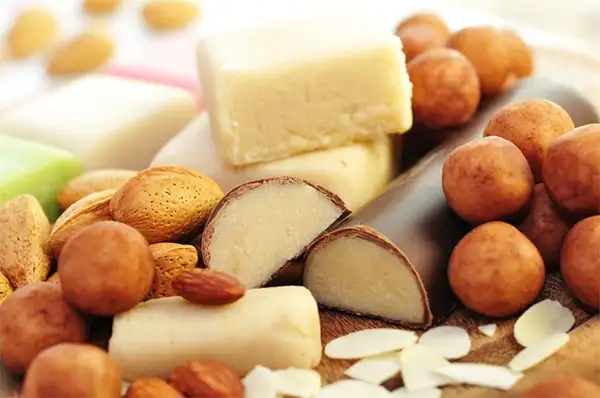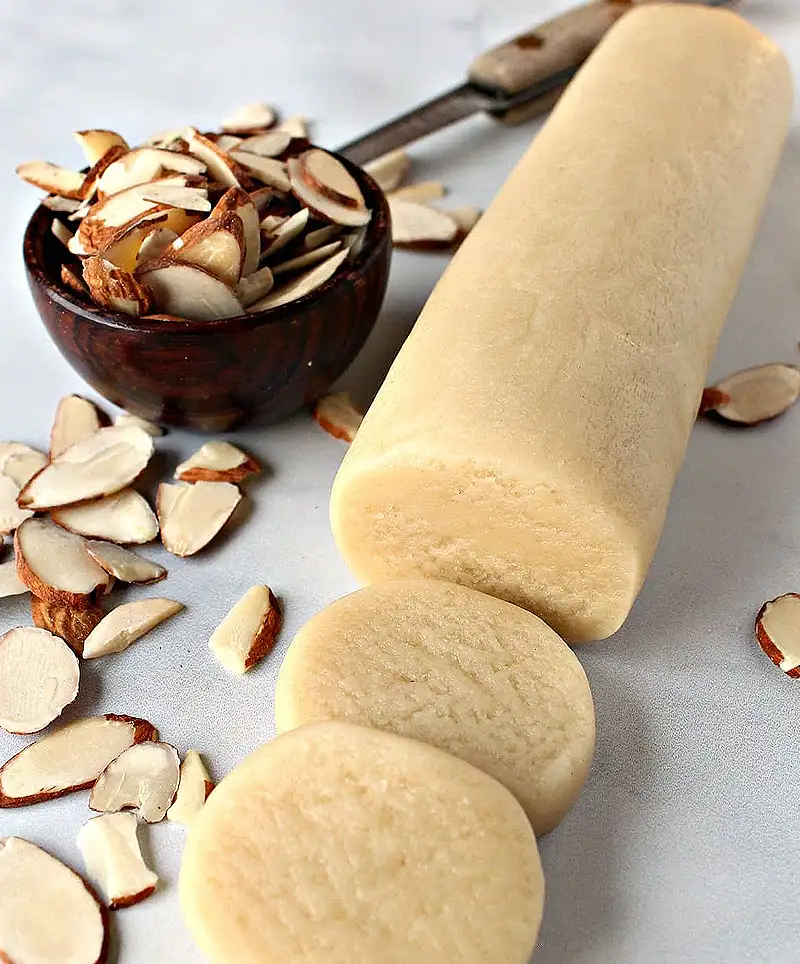A Sweet Excuse to Play With Your Food
Welcome to National Marzipan Day, the sweet celebration dedicated to the almond delight that has been mystifying taste buds and inspiring confectionary artists for centuries. On this special day, marzipan steps out from the shadows of the dessert world to bask in the glory it so richly deserves. It's not just about indulging in this sugary treat; it's about exploring the boundless creative potential it holds. Whether you're molding it into ornate shapes, enhancing your baking masterpieces, or simply savoring its unique flavor, National Marzipan Day is a chance to honor this versatile, almond-infused wonder. From the kitchens of amateur bakers to the showcases of professional pastry chefs, marzipan is the unsung hero of the culinary world, and today, we're here to sing its praises. So, gather your rolling pins and your imagination – it's time to celebrate the art and joy of marzipan in all its sweet, nutty glory.
The Sweet History of Marzipan
Tracing the origins of marzipan is like following a trail of almond crumbs through the pages of history. This confection, as enigmatic as it is sweet, has a past that is debated by culinary historians and sweet-toothed scholars alike.
One popular tale takes us back to the Middle Ages, to the cloisters of Europe, where it is said that marzipan was born out of necessity during a famine. When flour was scarce, resourceful monks in the monastery kitchens turned to almonds and sugar, creating a nourishing paste and a symbol of hope – a sweet silver lining, if you will.
Others argue that marzipan's roots lie further east, in the Persian Empire, where luxury and opulence were the order of the day. Here, almonds and sugar were mixed to create what was then a delicacy fit for royalty and poets, who probably mused about its virtues in flowery verse.
There's also a slice of marzipan history that credits its invention to the town of Lübeck, Germany. This city claims to be the marzipan capital of the world, where the sweet paste was perfected by skilled confectioners who guarded their secret recipes like precious jewels. Lübeck's marzipan was, and still is, a symbol of artisanal craftsmanship and pride.
As we leapfrog through history, marzipan became a canvas for confectionery art in the courts of Europe. Imagine banquet tables in Renaissance Italy or Baroque Spain, adorned with marzipan sculptures that were as much a feast for the eyes as they were for the palate. These were not mere desserts; they were edible expressions of wealth and status.
Recently, marzipan has taken a slightly more humble, though no less beloved, role in our kitchens and confectioneries. It’s become a staple in holiday treats and a favorite tool for adventurous bakers worldwide.
 Marzipan has been a survivor, a luxury, an artist’s muse, and a sweet treat for the masses throughout its storied past. Its history is a tapestry woven with threads of necessity, luxury, creativity, and pure, unadulterated joy. So, as we roll, shape, and taste marzipan today, we're not just enjoying a confection; we're savoring a piece of history that has been sweetening our lives for centuries.
Marzipan has been a survivor, a luxury, an artist’s muse, and a sweet treat for the masses throughout its storied past. Its history is a tapestry woven with threads of necessity, luxury, creativity, and pure, unadulterated joy. So, as we roll, shape, and taste marzipan today, we're not just enjoying a confection; we're savoring a piece of history that has been sweetening our lives for centuries.
How to Celebrate
- Sculpture Extravaganza: Why not turn your kitchen into a pseudo-art studio? Craft marzipan into anything - a replica of your cat, a less-than-accurate Eiffel Tower, or even a tiny, edible version of yourself.
- Marzipan Tasting Party: Gather your friends for a marzipan-tasting party. Watch as they try to distinguish between “exquisite almond delight” and “fancy sugary playdough.” Spoiler: they taste the same.
- Dress Up Your Desserts: Add marzipan to every dessert you can think of. Marzipan-topped pizza, anyone? How about marzipan garnish on your spaghetti? Let's get wild.
- Marzipan Pranks: Replace everyday objects with marzipan replicas. Watch the confusion as someone tries to use a marzipan remote control. Disclaimer: We take no responsibility for marzipan-induced trust issues.
Fun Facts to Chew On
- Marzipan's Identity Crisis: Marzipan has been through more identity changes than a spy in a blockbuster movie. In Germany, it's marzipan; in France, it's massepain; in Italy, it's marzapane. And in the world of children's birthday parties, it's often disguised as cartoon characters that look just slightly off.
- The Lübeck Legend: Lübeck, Germany, isn't just claiming to be the marzipan capital of the world; they live and breathe this stuff. There's a rumor that the air in Lübeck is 5% marzipan-scented. Okay, not really, but wouldn't that be something?
- Marzipan in Art: During the Renaissance, marzipan was the Play-Doh for grown-ups. Artists would sculpt elaborate scenes, which probably led to the first-ever instance of someone saying, "Don't play with your food," followed by, "Oh wait, that's actually quite impressive."
- Celebrity Status: In the 18th century, marzipan was such a luxury item that it rubbed elbows with kings and queens. It was the caviar of the dessert world and probably had its own tiny, fancy chair at royal banquets.
- The Great Almond Deception: Some marzipan isn't all almond. In certain recipes, apricot or peach kernels are used as a substitute, leading to what we can only call "nut fraud." Delicious but deceptive.
- A Doctor in the House: In the Middle Ages, marzipan was believed to have medicinal properties. It was like the Tylenol of its day, but tastier and with zero clinical evidence.
- Marzipan Museums: Yes, they exist. In some places, you can stroll through halls of marzipan sculptures, from life-sized politicians to tiny animals. It's like Madame Tussauds, but the sculptures are more delicious (and less creepy).
- Space Marzipan: In a twist that no one saw coming, astronauts in the early days of space travel were given marzipan as a part of their food supply. It's one small step for man, one giant leap for marzipan-kind.
 So, as you can see, marzipan isn't just a sweet treat; it's a cultural and historical chameleon with a resume that would put most desserts to shame. Whether it's gracing the tables of royalty, floating in space, or being molded into a slightly wonky lion at a child's birthday party, marzipan continues to surprise, delight, and occasionally confuse people worldwide.
So, as you can see, marzipan isn't just a sweet treat; it's a cultural and historical chameleon with a resume that would put most desserts to shame. Whether it's gracing the tables of royalty, floating in space, or being molded into a slightly wonky lion at a child's birthday party, marzipan continues to surprise, delight, and occasionally confuse people worldwide.
Let's address the almond-flavored elephant in the room: some people love marzipan, and some people think it’s what disappointment tastes like. This National Marzipan Day, let’s all agree to disagree. Whether you’re a marzipan maestro or someone who’d rather eat their hat than a piece of marzipan, today is a day for everyone.
National Marzipan Day is not just about eating; it's about appreciating the versatility of this sweet, almond treat. It’s a day to unleash your inner artist, challenge your taste buds, and maybe even prank your friends. So, grab that block of marzipan and make this day as memorable as the questionable marzipan sculpture you’ll undoubtedly create.
Please Share our Content






 Marzipan has been a survivor, a luxury, an artist’s muse, and a sweet treat for the masses throughout its storied past. Its history is a tapestry woven with threads of necessity, luxury, creativity, and pure, unadulterated joy. So, as we roll, shape, and taste marzipan today, we're not just enjoying a confection; we're savoring a piece of history that has been sweetening our lives for centuries.
Marzipan has been a survivor, a luxury, an artist’s muse, and a sweet treat for the masses throughout its storied past. Its history is a tapestry woven with threads of necessity, luxury, creativity, and pure, unadulterated joy. So, as we roll, shape, and taste marzipan today, we're not just enjoying a confection; we're savoring a piece of history that has been sweetening our lives for centuries. So, as you can see, marzipan isn't just a sweet treat; it's a cultural and historical chameleon with a resume that would put most desserts to shame. Whether it's gracing the tables of royalty, floating in space, or being molded into a slightly wonky lion at a child's birthday party, marzipan continues to surprise, delight, and occasionally confuse people worldwide.
So, as you can see, marzipan isn't just a sweet treat; it's a cultural and historical chameleon with a resume that would put most desserts to shame. Whether it's gracing the tables of royalty, floating in space, or being molded into a slightly wonky lion at a child's birthday party, marzipan continues to surprise, delight, and occasionally confuse people worldwide.








 "Sláinte!" is a traditional Irish expression used as a toast, equivalent to "Cheers!" in English.
"Sláinte!" is a traditional Irish expression used as a toast, equivalent to "Cheers!" in English.